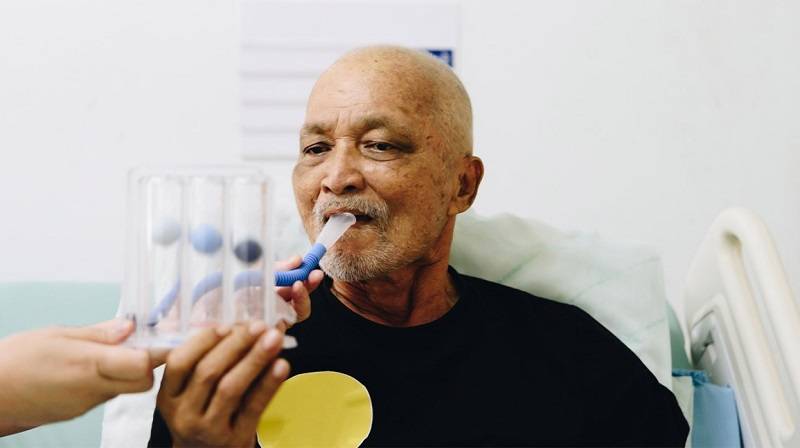. Dr. Veena Sisodia (MPT, NDT)

The most common breathing trouble faced in post covid population is shortness of breath. Sometimes shortness of breath is accompanied by chest pain. One can face this problem till one to two months. So what exactly is happening?
So when corona virus attack your body it damages the good cells (type 2 pneumocytes) which are responsible for elasticity and healthy lung. There is a release of cytokines and then a systemic inflammatory process. This causes lung oedema and microthrombus formation. This whole process affects the transfer of oxygen in body.
Also Read: Tips for Pregnant Women to Keep Diabetes Levels Under Check
Some patients remain asymptomatic or have very mild symptoms and other can have severe problems. There could be upper respiratory symptoms like sore throat, running nose, tiredness, fever. Over 50% of patients have dyspnoea that is difficulty breathing or shortness of breathing. In some patients it is accompanied by dry cough or productive cough.
For mild to moderate cases and even post covid, breathing exercises can increase the lung function. As guided by the government prone position can help in increasing your oxygen saturation. Prone position or lying on the stomach has been used in patients with acute respiratory distress syndrome (ARDS) for years.
Also Read: Nutrition hacks to strengthen your child’s immunity
Diaphragmatic breathing: before explaining this breathing exercise let us see what is diaphragm. Diaphragm is a big dome shaped muscle placed below lungs. It is a primary muscle of respiration. When we breathe in, diaphragm goes down and during breathing out it comes up. Mostly we breathe through upper chest that is thracoabdominal breathing, which means we use chest more than the diaphragm.
Also Read: Nutrition hacks to strengthen your child’s immunity
In this exercise keep one hand on stomach and one on upper chest. Now inhale slowly and deeply. Important thing is that your stomach hand should move forward which means your abdomen expands as diaphragm moves down and no or minimal movement in chest hand. Breathe out through mouth slowly and longer. Repeat it 10 times every hour. Don’t overdo it as it can cause hyperventilation resulting in mild dizziness.
Pursed lip breathing: Relax your shoulders take a deep breath from your nose. Now make a ‘O’ from your lips, just like the way you whistle and breathe out slowly and for little longer than your ‘breathe in’ time. If you breathe in for 2 sec then breathe out for 4sec.This too can be done 10 times in an hour. This exercise creates a small amount of positive end – expiratory pressure (PEEP). It supports the patency of airways and alveoli to participate in gas exchange.
Thoracic mobility exercises: these are simple exercises to open up your ribs and fill more air in lung segments. Stand straight; stretch both the hands above your head. Now side bend on your right side and take a deep breath in, exhale while coming back. Repeat it on left side. Do it for 5-10 times twice daily.
I have sputum while coughing
if you have productive cough (phlegm) then try active cycle of breathing technique.
Start with taking steam for 15-20 minutes. Then follow these steps:
STEP 1 Sit straight and long. Relax your shoulders and perform normal breathing.
STEP 2 Take deep breaths in and hold it for 5 sec. repeat it 2-3 times.
Repeat STEP 1 and STEP 2 for 2-3 times.
STEP 3 Perform HUFFING that is forceful expiration with open glottis. It could be long huffing or powerful short huffing.
Don’t get confuse between cough and huffing as they both are different.
How to use incentive spirometer.
Incentive spirometer is a device for respiratory exercise commonly given in lung illness. It’s easily available and easy to use. You need to relax shoulders, sit straight. Make a tight seal around the mouth piece and inhale deeply and slowly. Watch the flowmeter for visual feedback. If possible sustain the inhalation to create an end – inspiratory hold (4-5) sec. then relax seal around the mouthpiece and exhale , resume normal breathing with relax shoulders.
Pain in neck and shoulder.
Shortness of breath leads to overuse of accessory muscles of respiration, they are your neck and shoulder muscles. Try to keep them relaxed most of the time. You can give a mild massage to these muscles which help them in further relaxation. Incorporate mild stretching of neck muscles.
Postural hypotension. Some patients feel giddiness when they sit from lying position or when they stand. It is caused due to sudden drop of blood pressure when you sit or stand suddenly from lying position. Moving your ankles while lying, squeezing and relaxing your leg muscles for few seconds, moving slowly in sitting and then standing are some of the things which can help you in this condition.
6min walk test. After 10 to 15 days of infection you can perform this test on yourself. Walk for few min as per your tolerance and then measure your heart rate, oxygen saturation and level of fatigue. If you feel fit in this test you can start walking for 6-10 min twice a day. If you feel tired in between the test then does not push yourself, you need some more rest.
Do not push yourself for physical exercises too early. 1 month rest is very important, keep doing respiratory exercises.


Comments are closed.